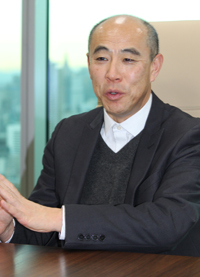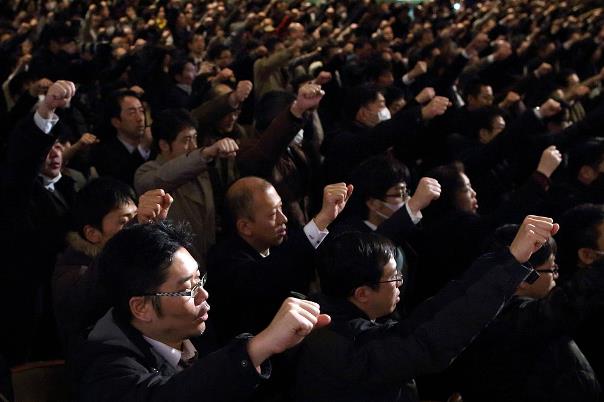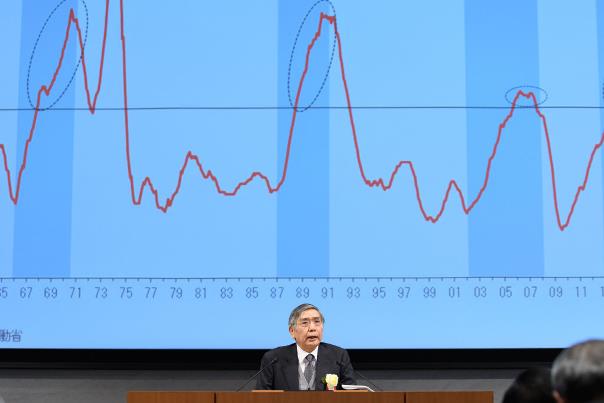- Article
- Macroeconomics, Economic Policy
Japan’s Economic Outlook in 2018 and Beyond: An Interview with Takeo Hoshi
January 22, 2018
Economist Takeo Hoshi, chair of the board of the Tokyo Foundation, talks about the successes of Abenomics, prospects for economic growth in 2018, and the challenges facing the Japanese economy further down the road .
* * *

―― In recent months, the ratio of job openings to applicants in Japan has soared to its highest level in decades. The stock market is having an excellent run, real estate prices are soaring, corporate profits are up, and Japan’s economic expansion continues. Would you credit the economic policies of Prime Minister Shinzo Abe for this strong performance?
TAKEO HOSHI: There’s no denying that the Japanese economy is growing. Hiring is up, and the labor market is getting tight, as evidenced by the high ratio of job openings to applicants. I think this signals the start of a virtuous circle in which higher wages will lead to growth in disposable income and eventually boost consumer spending to fuel further growth.
Turning Point for Wage Growth
HOSHI: Up until now, wages haven’t risen much even in a tight labor market, and there’s a reason for that. There is a substantial wage gap between regular and nonregular employees―that is, between full-time and part-time workers―and the share of lower-paid nonregular employees in the labor force is rising. That shift has prevented the average wage from rising in spite of wage increases in specific job categories. The tight labor market has pushed up wages for nonregular workers, though, and gradually we’re beginning to see the same effect for full-time workers. Meanwhile, growth in nonregular jobs as a percentage of the total now seems to be leveling off. That means it’s only a matter of time before the average wage starts to climb as well. I expect the trend will be evident by this coming spring. Companies have already stepped up capital investment substantially. Once wages begin to rise, consumption is also bound to pick up.
The Japanese economy is looking healthier, and I think it’s fair to attribute that to the expansionary fiscal and monetary policies of “Abenomics.” The Bank of Japan’s quantitative easing policy has finally succeeded at least in putting the brakes on deflation. But monetary policy can only stimulate demand, and that doesn’t necessarily translate into a commensurate increase in economic growth. Once wages and prices begin rising again, the effect of demand stimulus through monetary policy will dwindle, and growth will be constrained more by supply. So supply-side policies aimed at boosting productivity will be of the essence if we want to see the economy improve further. That means focusing on the third “arrow” of Abenomics.
By the same token, the government has probably reached a limit on what it can accomplish through fiscal policy. Japan’s public debt has continued to balloon each year; we can’t keep up this level of deficit spending much longer. The consumption tax hike that’s supposed to be implemented in October 2019 is just the minimum necessary condition for stabilizing government finances. It seems certain we’ll eventually need further tax increases as well as spending cuts.

The government needs to start showing that it takes fiscal discipline seriously. In this sense, I think it was a good idea to abandon the target of 2020 for eliminating the primary deficit. For the cabinet to cling to that unrealistic pledge after everyone knew it was out of reach would have been tantamount to admitting that it wasn’t giving any serious thought to fiscal discipline. So, this might actually be a step in the right direction. The problem, of course, is that the government has yet to come up with an alternative, achievable target. Even more important, it needs to draw up a realistic roadmap for achieving its new targets and stick to that program.
―― You said that the coming consumption tax hike was a minimum necessary condition for fiscal consolidation, and that other tax increases and spending cuts would be needed as well. Can you be more specific about what might be in order?
HOSHI: Basically, there are three ways to attack the problem of mounting public debt: reduce expenditures, increase revenues, or let inflation erode the value of the outstanding debt. Japan’s fiscal situation has reached the point where we really need to do all three.
The government forecast itself acknowledges that raising the consumption tax to 10 percent isn’t going to be sufficient. Even with that additional revenue, only a dramatic increase in economic growth could erase the primary deficit. So, we’ll need to increase tax revenues further―though not necessarily through the consumption tax―cut back on spending, and also create the kind of economy that can sustain a moderate level of inflation. All three are necessary.

―― A couple of years ago, Olivier Blanchard and Adam Posen of the Peterson Institute for International Economics argued that Japan should induce inflation by hiking wages by 10 percent. What do you think of that advice?
HOSHI: I agree that raising wages to induce inflation is a good idea. A 10 percent increase may not be realistic all at once, but if we could do it incrementally, beginning with, say, a 4 percent hike, that would be a step in the right direction. The government is considering tax breaks for companies that raise salaries, and it should also consider pay raises for civil servants. Another step it can take is to boost salaries in industries like nursing care and childcare, where wages are regulated, at least indirectly.
Taking a Cue from America and Europe
―― Some analysts have expressed concern that by continuing to pursue its expansionary monetary policy, the Bank of Japan could cause the markets to overheat and create another bubble. I’d like to hear your thoughts on the benefits and risks of the BOJ’s quantitative easing policy and the challenge of exiting from such a policy.
HOSHI: The current quantitative easing policy is on a different scale from anything seen previously. The BOJ has been increasing its holdings of Japanese government bonds at a rate of some 80 trillion yen annually, and this can’t go on indefinitely. It’s also problematical for the BOJ to be the largest sharedholder of many companies. The economy is finally looking up, so as soon as inflationary expectations take hold, it’s time to start heading for the exit. If that doesn’t happen, we could be heading for trouble.
The BOJ isn’t the only central bank in the world to adopt aggressive monetary policies to stimulate the economy. But most others have already begun tapering off. In the United States, for example, the Federal Reserve decided last December to raise the benchmark interest rate by another 0.25 points.
I think policymakers in Japan should watch these trends to work out when and how to wind down monetary easing. Thus far, the rate of inflation is still quite low, but the BOJ needs to make some decisions about how to proceed and what sort of signals to send to the market when it sees inflation picking up―whether by slowly raising interest rates or by gradually dialing back bond purchases and reducing its holdings. In this regard, we can benefit from the experience of the Federal Reserve, the European Central Bank, and other central banks.

Japan has been a pioneer in the aggressive use of such unconventional monetary policies as zero interest rates and quantitative easing, and other countries have learned a lot from Japan’s experiment. Conversely, when it comes to exiting such policies, I think Japan can learn from the example of other countries.
I’m not as concerned about the risks of too much monetary accommodation as I am about the possibility of fiscal insolvency. The most important thing now is for the government to acknowledge the fiscal risk and plan in advance on how to respond in the event of an emergency. Just showing investors that the government has a long-term plan for fiscal sustainability and stability would help more than anything to shore up confidence and avert such a crisis. On the other hand, if you wait until a crisis breaks out to formulate a response, there’s much less room to maneuver.
―― The Greek approach, you mean?
HOSHI: Greece actually had more options because it could default on its external debt and shift the losses to foreign investors. But almost all of Japan’s government bonds are held by Japanese investors, so if the Japanese government defaulted on its debt, the Japanese people would ultimately bear the brunt. Also, if you have external debt denominated in your own currency, you can reduce what you owe by letting the currency depreciate, but that option isn’t open to Japan. The only way Japan can reduce the real value of its public debt is through inflation, which would hurt Japanese consumers.
Economic Challenges for an Aging Society
―― By 2025, Japan’s baby-boomers will be over 75, which will put them in the category of the “advanced elderly.” This is bound to have a huge impact on the budget. What’s the economic outlook for Japan farther down the road, as society continues to age?
HOSHI: Japan’s systems, as typified by our social security system, were not designed with a top-heavy population pyramid in mind. We have to correct that mismatch. It’s clear that without such reforms, we’re going to face big problems in the future. These problems aren’t going to suddenly appear in 2025 or 2026. They’re already emerging, and they’ll get worse in the years ahead.
Reducing the amount that we spend on seniors is important, but we also need to design systems that help them to enjoy a productive life even as they age. The category of “advanced elderly” encompasses those aged 75 and up, but today’s 75-year-olds are probably as healthy as 55-year-olds of the past. Many septuagenarians are still able to work, and many are eager to.
We need to develop a system in which the elderly can continue contributing to society, as opposed to one in which everyone automatically retires and starts receiving pension benefits at a certain age. I believe we’re going to see the evolution and spread of more flexible working styles, including the gig economy, in which people young and old can take advantage of work opportunities as they arise.
I think the problem that people most often associate with the advanced elderly is healthcare costs. There’s been a tendency for costs to climb as medical science advances, so we need to start giving thought to more cost-effective ways of supporting good health. There are healthcare reforms we can implement to promote lifestyle changes and encourage greater emphasis on preventive care. Offering discounted health insurance premiums to people who adopt healthy lifestyles is one idea.
Let’s look on the bright side for a moment. There’s this idea going around that population decline and demographic aging spell the end of economic growth for Japan. But demographic factors are just one part of the equation. During Japan’s rapid-growth period, for example, GDP rose at an annual rate of around 8 percent, but only 1 percentage point of that increase can be attributed to population growth. The rest was the result of productivity growth. So, instead of using population decline as an excuse, we need to think about ways to improve productivity and develop policies to that end. To put it another way, as long as we can implement the reforms needed to boost productivity, we have nothing to fear from aging or population decline. Viewed in that light, the long-term prospects for the Japanese economy begin to look a lot brighter.
(Interview conducted by the Tokyo Foundation public communications department on December 12, 2017. The original article in Japanese can be read here: https://www.tkfd.or.jp/research/research_other/m3qxl4)
